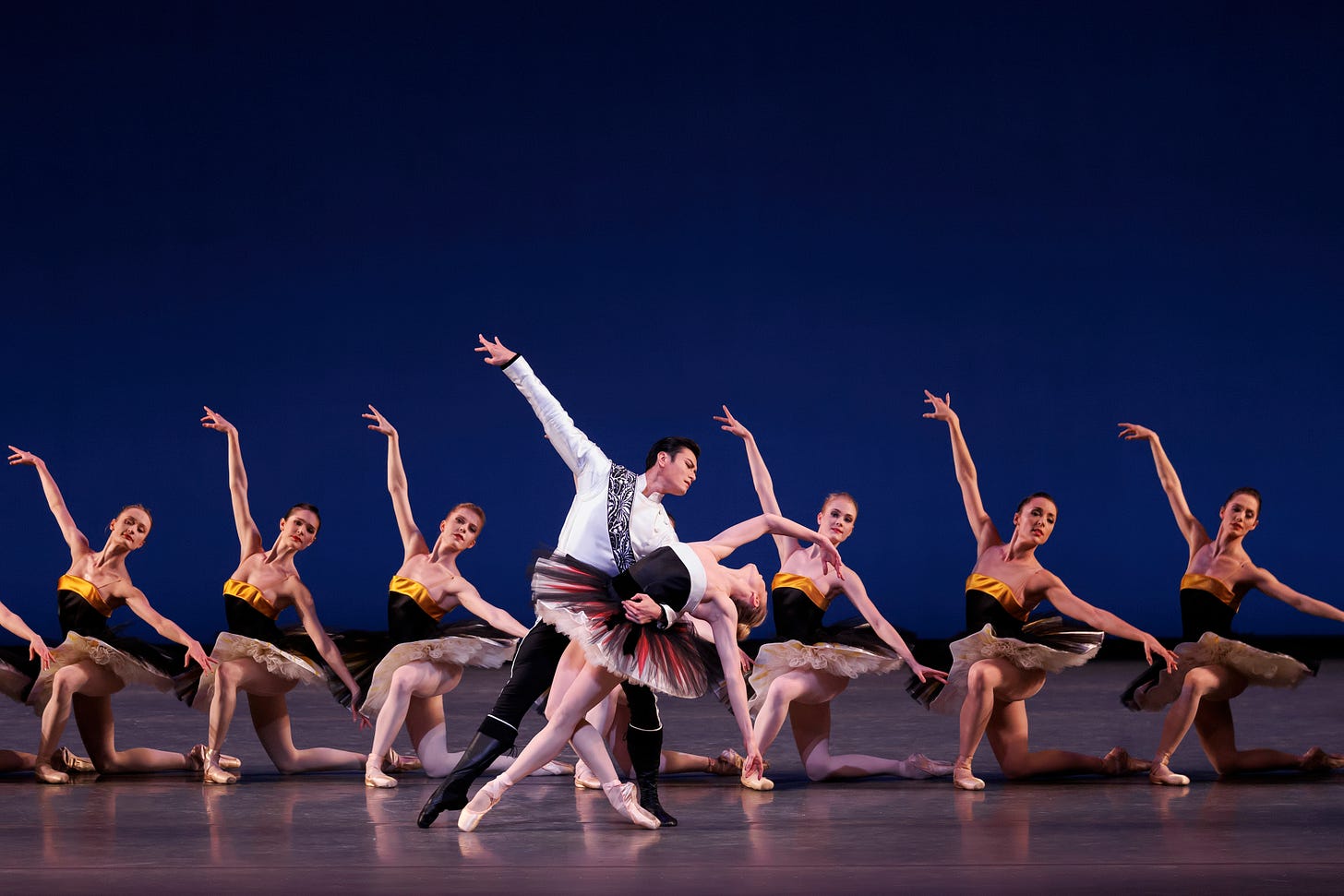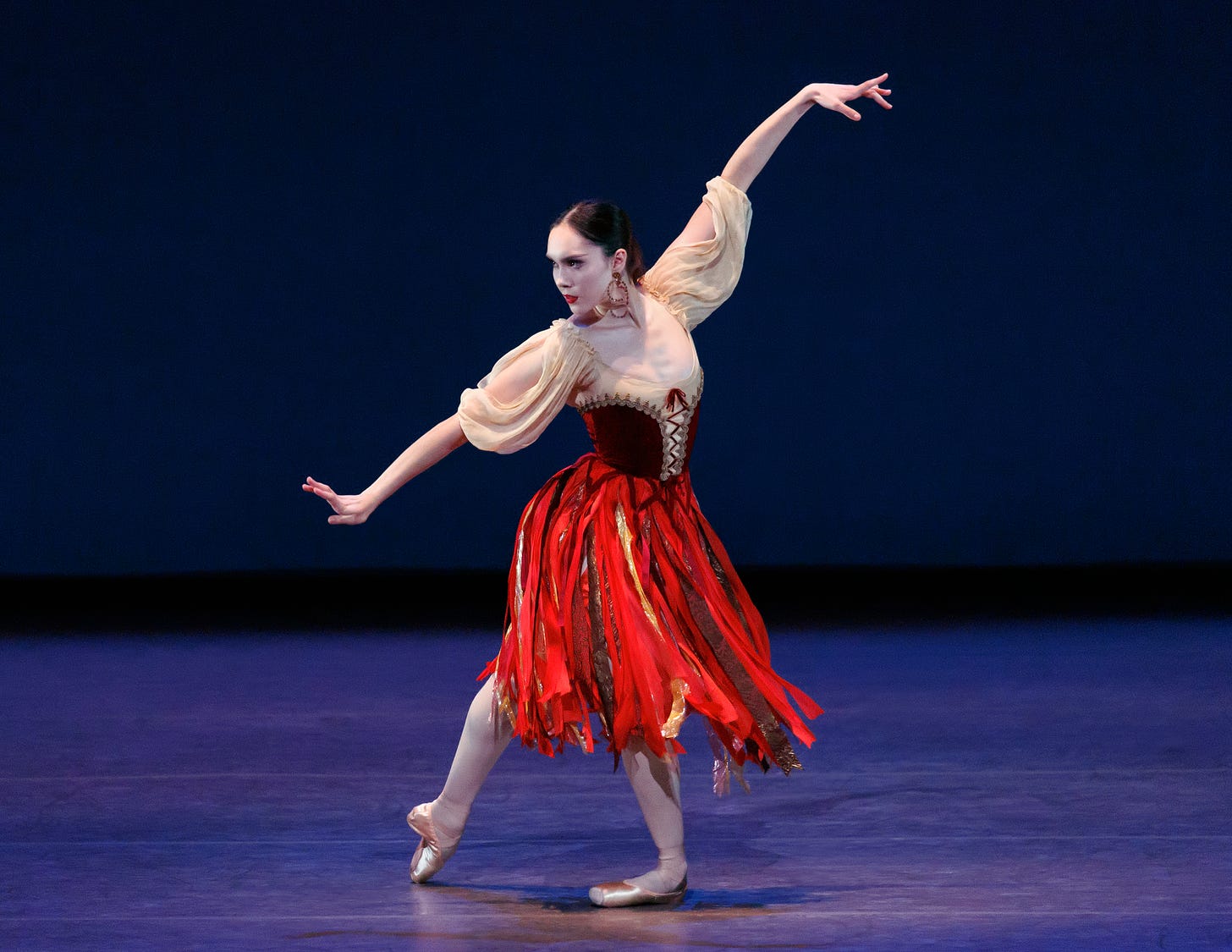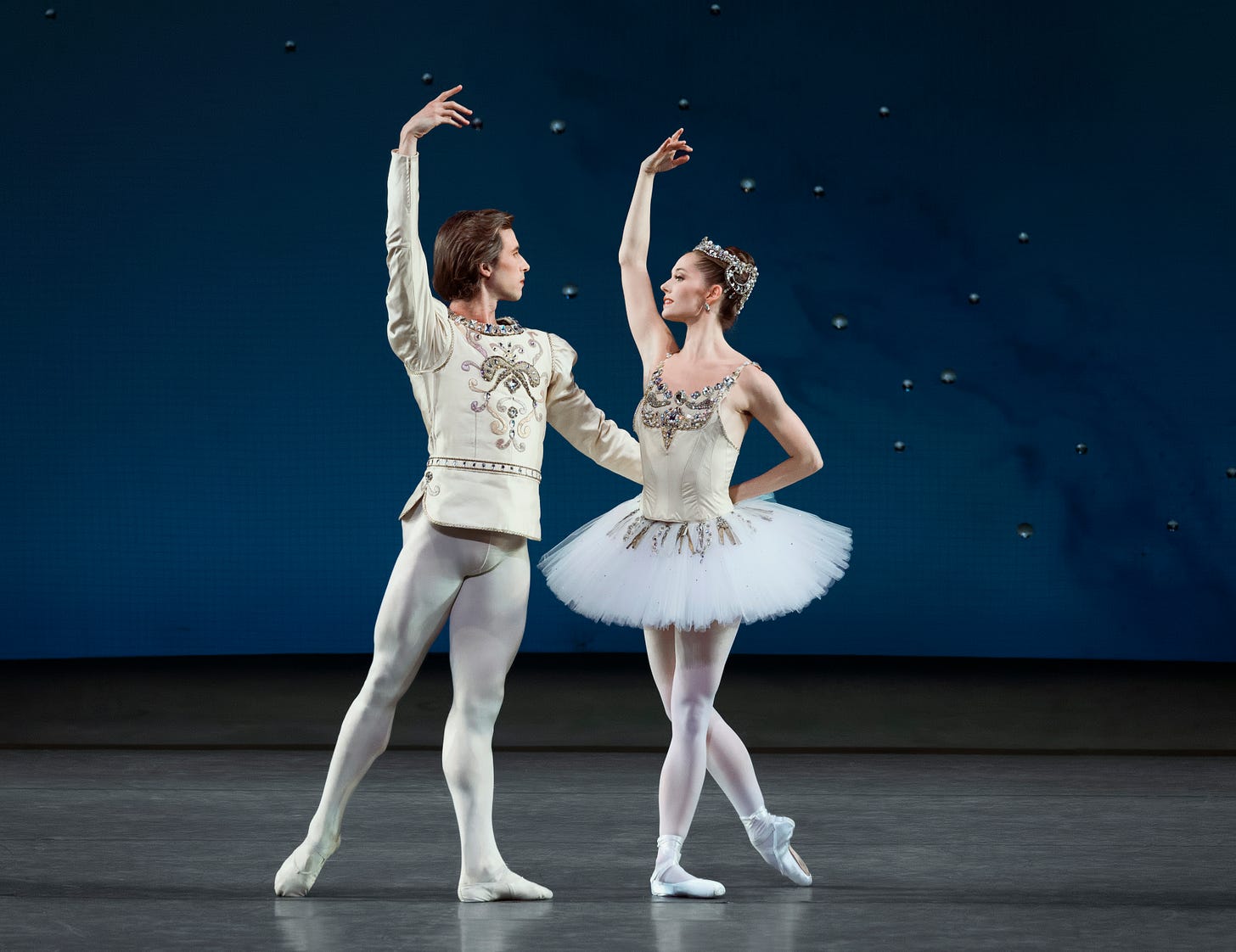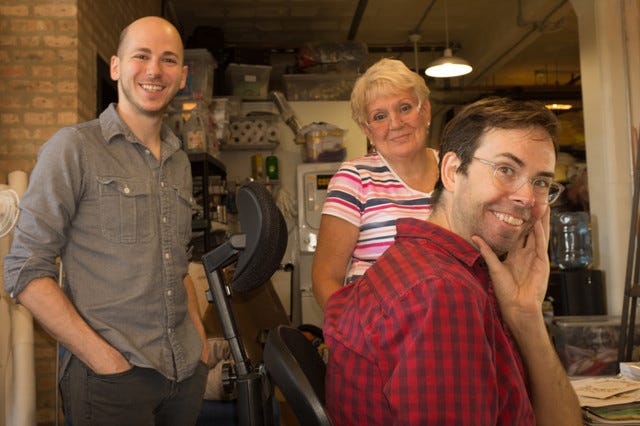Appalachian Dreams, Part II
Jarod Lewis’s journey from rural Kentucky to New York City Ballet’s costume shop
Welcome back to my conversation with Jarod Lewis, manager of New York City Ballet’s costume shop. In Part I we talked about his origin story, the immense scope of the department’s work, and the artistic relationship between George Balanchine and legendary City Ballet costumer Barbara Karinska. Now we’re gonna do some serious tutu math, get Lewis’s big-picture perspectives, and wrap up with some Appalachian life inspo. Without further ado, here’s Part II.
CB: Your team rebuilds Karinska’s costumes when the vintage originals need to be replaced. Is there anything you’ve learned from that?
JL: Let’s say a costume needs to finally retire, and it was an original Karinska. We meticulously figure out what went into it, the sewing techniques, the fabric. Why was this tutu sewn this way, but this tutu that she made or designed two years later sewn this other way? All these little engineering changes play a big factor into what’s happening aerodynamically on stage, what’s happening with the outfit as it moves around the body.
There are three main silhouettes of tutus. There is the classical that most people know as the one that’s flat across. You have the romantic, which is the long, flowy one. And then you have one that’s in between, which is the bell tutu. Globally, it’s recognized that those are the three silhouettes of tutus. Well, Karinska created one called the powder-puff tutu, which is in between the classical and the bell. And the first time I got to see one and dissect it—it is an engineering feat. It’s hard to explain the math that goes into making these tutus that Karinska developed with her team at the time. For [Ratmansky’s] Paquita that premiered last winter, that’s a standard tutu silhouette that we make, with 13 layers of fabric, and each layer is 7 1/2 yards. If you were to take all 13 layers and lay them end to end, starting with 2 inches to 13 1/2 inches, that’s 97 1/2 yards of net. That’s a football field.
CB: In one tutu.
JL: In one tutu. And we actually put an extension on one of the layers that was a 3:1 ratio. That extension was, I think, 22 1/2 yards. So that’s 120 yards.
CB: So now you have the end zones included. That’s a full football field.
JL: Yeah, for one tutu. That doesn’t include the bodice, that doesn’t include anything else. To be able to take all that fabric—it basically turns into a giant cotton ball—and then steam and tack it. Tacking is the sewing technique of taking each of the layers of the tutu and then hand sewing it so that it creates the exact silhouette. I’m to a point now in my artistry and mastery of tutu making that you could sew together five tutus exactly the same, and then if you tell me five different silhouettes of that type of classical tutu or bell tutu, I know how to manipulate all the fabric so I can make go perfectly straight out, or I can make it dip and swoop back up, or I can make it have this soft pancake look. All that comes from the hand-tacking techniques, which either comes from experience or from one master teaching their apprentice or a co-worker.
To know now how to make a Karinska powder-puff tutu, to actually know it, it’s really humbling. Like, wow, I’m one of the few people globally who know how to make this piece of art. Having Karinska’s lineage that’s passed down more and more with each person that joins us, is truly amazing. Because everything we make, from remaking it to something new, and this includes the Fall Fashion Galas, everything is created in the idea that Karinska is still in that shop, and she is the one even overseeing Marc to make sure that everything is exactly how she would have wanted it.
CB: So what you said earlier, about dances being co-created between Balanchine and Karinska—did he trust her to create costumes that would enhance the movement? Or did he have ideas about what he envisioned for the costumes? Because from what you’re describing, and I never thought about this way, but the costume’s design and execution would have an enormous impact on what the dance looks like and the movement of the dancers.
JL: It always starts out as a conversation, even today. Let’s say for this year that there’s five new ballets. We’re gonna have these five different choreographers come in. They typically will find either a composer to write new music or there’s music they have in mind, and then they pick a designer who they want to be collaborating with [on costumes]. The designer will draw their sketch or their rendering, and then that’s then handed to Marc to figure out all the artistic parts, what’s actually doable, what’s not doable, and then that makes its way to my team and I.
The designer has to be fully aware of what the choreographer is wanting to do with the dancers. Because if you’re wanting a bunch of partnering, that means we can’t have any design going across the waist of the bodice of the women, because when they’re turning, that has to be completely smooth for the safety of the men. So if they really want designs to be happening up on the top and then move all the way down, the designer has to understand, okay, how can this be executed? How can this still be translated? And then how can it still function? And that’s when Marc comes into play: If you’re wanting this, this is how we can do it, versus not. And this is how it’s been going on since Karinska and Balanchine. It’s always a conversation of, what do you want the dancers to be doing, how are you imagining them to be looking even like in a very simplified way? And then the designers have to interpret what the choreographer is describing —like, “I want it to be like clouds,” or “I want it to be like fire.” They’ll sometimes use these descriptive words that the designer and Marc will translate into options.
An example would be Tzigane, which we now call Errante. During that moment when Mira Nadon last year first walked out on stage, that skirt, when she spins, has to explode out like the fire at a campfire—you throw a log on, and you know how sparks can just come out into the air, and those embers? We had to figure out how to do that. Originally, Karinska did that. Her team executed it. And I’m trying to remember who the designer was, because Karinska was, for that ballet, more like Marc. Sometimes she was designing, and sometimes she was being the costume director; [for that ballet], she was the liaison. We have Suzanne Farrell’s original costume, so we didn’t have to just look at photos. Suzanne came into the shop several times, and we got to work with her to understand what this costume was originally like, because it is now so old and has been worn so much that the skirt is just tattered ribbons. The fabric is cut on the bias, so at a 45-degree angle; that way it can stretch and literally breathe as it’s moving through the air. And by having all these different subtle colors of reds and purples and oranges, when Mira stepped out on stage, and that first spin, it looked like a campfire exploded.
CB: You posted a time-lapse video on Instagram of yourself building a new Diamonds tutu—you had the mannequin in front of you, and you were just turning it and tacking the tulle, layer after layer. You reduced it down a few minutes. How long did it actually take you to build one of those tutus?
JL: Just the tacking part—if I was not interrupted, because I was still doing my job as shop manager—that specific silhouette, the principal tutu is constructed like a powder puff, but it has to be reshaped to be more like a bell. I tacked those for Isabella LaFreniere and Unity Phelan, and I want to say each one was 5 hours of work, just tacking it to get the exact shape.
CB: What comes after the tacking is done?
JL: Then it’s attaching the bodice that someone else has been working on, to make it one cohesive piece. But a single tutu, even for us, something as complex as one of the Diamonds principals, from beginning to end—from the pattern being brought out of storage, because it’s an existing ballet—something like that is, minimum, three different fittings, cutting, sewing, hand sewing all the beads and the jewels. It’s close to 100 hours of work for one tutu.
CB: Wild. And how many did you end up making?
JL: That year, because we were just remaking the skirt part of the tutu [“tutu” is used interchangeably for the skirt and for the entire costume, encompassing skirt, bodice, and sleeves], there’s about 20 of them [for the corps]. So just the [corps] skirts, each one of those takes half the time…so 50 hours…20 of those—that would be 1,000 hours of work just to remake the skirts.
CB: And that’s all by hand?
JL: There is machine sewing, of course, because we’re not insane. [laughter] But the tutu skirt is all by hand. You can’t do that on the machine. The trunk, what is against the body, that’s machine made. And then the gathered rows that have to be put on to take it from the 7 1/2 yards down to however big the dancer is, those are machine sewn on. But they have to be hand gathered all the way down. The gathering alone takes about 30 to 45 minutes, depending on your dexterity. Even me going at my fastest is about 45 minutes per layer.
CB: Per layer?
JL: Per layer. It’s basically a day of work of just gathering everything down.
CB: Given all of this—and what we’ve talked about today is just a micron of what goes into creating a season’s worth of costumes for City Ballet—are there things that you wish that dancers knew about what you guys do?
JL: Yes. We have all taken our own journeys, mine being from a musician, to this. Some people, it has been from since they were a kid, when they first touched a sewing needle, and now this is what they do with their life. They’ve dedicated their hands the way a dancer dedicates their feet to this craft. If you could see the hands of some of our stitchers—one, Regina Abayev, this is her thirtieth year at New York City Ballet. She has been making the costumes for some of our dancers for as long as—actually, for the majority of them, longer than they’ve been alive. She has seen their names as she hand sews their label in, from being an apprentice up through retirement, and sometimes as a [School of American Ballet] dancer. We know more about our dancers than sometimes our dancers even know about themselves.
We’re making your armor for when you go on that stage. And our costumes, especially the bodices, some people describe it as a suit of armor, because every single one that we make is curated specifically to your body. That’s why we do so many fittings. We have to make sure that it fits you perfectly. It is our livelihood to make sure that when you are dancing, that when you bow, when you’re doing every type of movement you shouldn’t once have to think about your costume. It should literally feel like it’s part of your body. If you’re worried about how something is fitting you, we’ve failed our job as artists.
New York City Ballet has the Balanchine Trust and the Robbins Trust and everyone else to make sure that every time a dance is performed, it looks identical. That’s our job as well. It’s why we’re so anal about, like, the color of things in the fitting room. We have stage lights in there so that we can turn off the overhead lights and see what things will look like onstage, which is important for making sure the color of your tights match you. The tights are not going to match you when you’re outside or under fluorescent lights; we’re matching it for when you’re dancing under stage lights. You’re moving around, your blood pressure is increasing, your blood flow is increasing, and every single person will then get this flushness, so when you’re standing in the fitting room, we actually add a touch of pink to every single pair of tights to compensate for that, so that in that moment [onstage], you look the most cohesive and most beautiful that you can be.
CB: And the follow up to that is, is there anything that you want audiences to know about what you guys do?
JL: [There are so many] different backgrounds: a tailor, someone who does alterations, a seamstress, a stitcher, a milliner, a haberdasher, a cobbler, a tutu maker. There’s no sole word that describes them. All of them have different words and meanings. The term stitcher is actually specifically for theater, because you’re stitching every type of garment. You could be doing menswear, women’s wear, tutu making, stretch wear you could be working on, hats, shoes, you are stitching together all the different things. That’s the general term we use for anyone who is sewing in theater.
Then you have, like I said earlier, the drapers, who are the patternmakers; the assistant drapers, who are learning to be the drapers. You have the cutters—in some places, they’re called the “first hands” because their hands are the first ones to touch the fabric, in the sense of it being used as the costume. The draper, they’re over there with paper, doing everything. So [the cutter is] the first one to actually take the pattern, put it to the fabric, and start cutting it. Every single one has a meaning and a reason for it. We’re all skilled in such different ways.
CB: Yeah, the mechanisms of the magic are just incredible. And when the costumes are being designed and crafted, they have to be made with backstage changes in mind as well.
JL: Yes. Is it going to be a zipper? Is it going to be snaps? Is it going to be hooks and bars? Is it going to have a stretch component to it so that it can just slide over the shoulders and you shimmy your way out of it? All these things happen in the process from the design to the finish. It’s, “Okay, choreographer, what’s happening? Is there a quick change, and where is the quick change?” Because where a dancer exits and then reenters will determine what we have to do in the costume shop to make it ready for the wardrobe teams.
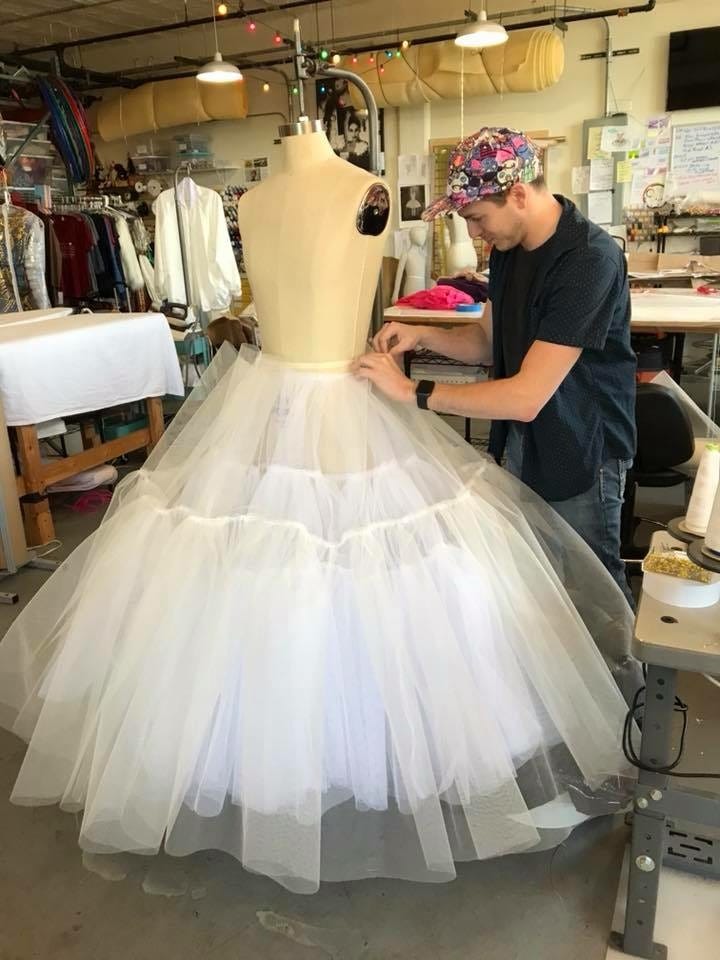
CB: Okay, so this one is your choice. Do you want to sum this up by talking about what’s the most challenging part of what you do? Or by talking about the most fun part?
JL: Hmm. Fun.
CB: Okay, what’s the most fun part of this job?
JL: For me, the most fun part comes to a couple different things. Last year was my first time actually getting to go over during one of the student matinees. I was just standing up there at the fourth ring, and it was a packed house, and you heard these kids go, Wow. Like they would all take a gasp together. It was a guttural response. Adults might internalize it, but they’ll just sit there. But for a child, it’s magical—they’re seeing something for the first time onstage that could be impacting their life, could be changing everything. I mean, for me, it was at 16, going to Walt Disney World and seeing Cirque du Soleil. Seeing that show is what inspired me to be who I am today.
One of the other things is, if you imagine life as this clear pond that’s a reflection, and there’s little ripples happening everywhere, and everyone in life is being affected by these ripples of some kind—someone always has to be the thing that throws that pebble into the water to cause the ripples to be affecting everyone else. I truly believe, working at Lincoln Center, we’re one of the few places in the world that constantly gets to be throwing those pebbles that affect everyone else in life, from the New York Philharmonic to the Metropolitan Opera and the New York City Ballet, Jazz at Lincoln Center, Lincoln Center as a whole. And then Juilliard—the fact that they get to be students at the beginning part of their career, of their life, as young adults at Lincoln Center. We get to share a cafeteria together, and to see people from the early stages of their career to those who are basically at retirement interacting together is awe-inspiring. It makes it feel normal as well—like, “Oh, this is where I am, like every person who works at Lincoln Center, it wasn’t a mistake. You were chosen for a reason to be at the pinnacle of art across the world.” It’s amazing. It’s humbling.
CB: It’s wonderful to hear you speak of it in those terms, because it’s such a special thing. It’s a thrill to get to go there and see this art and be a part of this world. I hope everyone can feel that in their life.
JL: Yeah. You know, growing up in Appalachia, the closest movie theater to my parents and I was 40 miles away. That was when we got to go see a movie. There was no theater. There was a little roadhouse about 60 miles away where every Christmas they would perform Nutcracker. The closest actual stage theater was over 100 miles away. People like me, we didn’t even get to experience art, because the internet was still so young back then. If you don’t know something exists, how would you even know to look it up?
Probably the most amazing part about even getting to do my job is the fact that I come from Appalachia, where the idea of me being in this position should have never happened. And I really hope that out of all the achievements I ever get to do in life, I hope that I even get to inspire one person back home to be doing what they want to do. It doesn’t have to be making tutus for a career. If they want to be the best pipe welder that they can be, if they want to be the best nurse—they don’t even have to be the best at something. It’s to understand that you can be a hillbilly and achieve dreams.
Follow Jarod Lewis on Instagram at @snayls. New York City Ballet’s 2025–2026 season opens on September 16 at the Koch Theater, and the Fall Fashion Gala takes place October 8.


